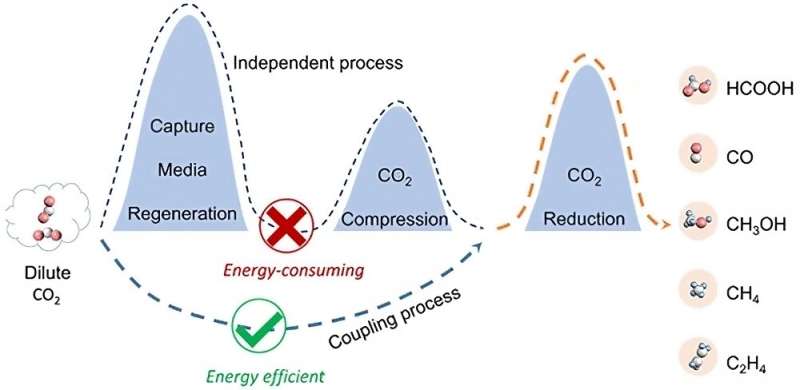This article has been reviewed according to Science X's editorial process and policies. Editors have highlighted the following attributes while ensuring the content's credibility:
fact-checked
peer-reviewed publication
trusted source
proofread
Harnessing materials and mechanics science for a sustainable future

Cutting-edge materials science and engineering play a key role in clean energy conversion. Sustainable development sets the goal for researchers across disciplines, requiring active collaborations to optimize impacts. Dr. Xiao Zhang, Assistant Professor of Department of Mechanical Engineering at The Hong Kong Polytechnic University (PolyU), is leading research efforts focused on advanced materials and electrochemical reactors for clean energy conversion.
Dr. Zhang's research on sustainable energy sources and production has received significant citations, spanning multiple disciplines such as materials science, chemistry, chemical and mechanical engineering. The research focuses on achieving decarbonization through clean electricity with special emphasis on the production of valuable chemicals from the earth's abundant resources.
Engineering plays a crucial role in promoting sustainable development by creating solutions for energy systems, production, and resource management that can reduce carbon emissions, conserve resources and protect the environment. The primary focus of Dr. Zhang's highly cited papers is the exploration of novel layered materials for clean energy conversion. His research interests also extend to the conversion of waste pollutants such as carbon dioxide, nitrate and biomass into valuable chemical and fuels.
Dr. Zhang said, "I am thrilled by this prominent achievement to influence frontier sciences and subsequent innovative applications. Our research has enhanced scientific knowledge in materials science and chemical engineering, particularly in the understanding of 2D materials and development of electrochemical reactors for sustainable production."
Advancing the knowledge of material structures and catalytic processes is crucial to clean energy production. Dr. Zhang said, "Our research has facilitated the development of practical reactors capable of producing valuable chemicals at an industrial-relevant rate. These novel findings have significant impact on the development of sustainable manufacturing, environmental remediation and resources efficiency."
Novelty in research
Researchers work tirelessly to bring scientific breakthroughs. Dr. Zhang's works have unraveled fundamental theories and technologies in materials sciences which serve as useful references for other researchers to explore further across various disciplines.
Dr. Zhang said, "I'm encouraged by our highly cited works, which eventually bridge the gaps between frontier scientific findings and practical production applications." For instance, one of his highly cited research on catalytic interface engineering and electrochemical reactor has facilitated the design for hydrogen peroxide (H2O2) production.
The study "Electrochemical oxygen reduction to hydrogen peroxide at practical rates in strong acidic media" was published in Nature Communications in 2022. The research presented a cation-regulated interfacial engineering approach to promoting the H2O2 selectively under industrial-relevant generation rates in strongly acidic media. A double-PEM (proton exchange membrane) solid electrolyte reactor was further developed to realize a continuous, selective and stable generation of H2O2.
Practically, the acidic H2O2 solution delivers a wider range of applications and greater demand. This strongly motivates studies in the high-performance electrochemical generation of H2O2 in acidic media.
Another novel study in material sciences demonstrated a unique approach to structure tuning of material, resulting in effective manipulation of its catalytic properties and functionalities. The research meticulously investigated structural change during the lithiation-induced amorphization process. The highly cited research, "Lithiation-induced amorphization of Pd3P2S8 for highly efficient hydrogen evolution" was published in Nature Catalysis in 2018.
The study showcased a breakthrough in the amorphization of layered materials, transforming inherently non-catalytic materials into highly efficient catalysts for cathodic hydrogen production. The atomic-level structural engineering of inorganic materials has proven to be a compelling strategy for tuning their physical, chemical and electronic properties, thus enhancing their performance in various applications, particularly in electrocatalysis.
Increasingly concerns about the rising levels of carbon dioxide (CO2) and its influence on climate change have made it essential to create efficient strategies to reduce CO2 emissions. Dr. Zhang's team identifies the potential of integrating CO2 capture and electrochemical conversion as a promising approach to tackle this challenge.
Recently, Dr. Zhang and his research team have made a noteworthy advancement in the sustainable energy field through their groundbreaking study published in ACS Energy Letters. The review paper "Integration of CO2 capture and electrochemical conversion" delves into the exploration of combining CO2 capture and electrochemical conversion.
A comprehensive investigation was conducted in the study to develop an efficient and sustainable system that captures CO2 from emission sources, and subsequently converts it into valuable chemicals or fuel.
The findings provide valuable insights and practical strategies for researchers, policymakers, and industries working towards sustainable CO2 management and developing a circular carbon economy. The integration of CO2 capture and electrochemical conversion can help us move toward a greener and more sustainable future.
The transition from the ubiquitous goal of sustainability and clean energy to intricate scientific concepts and discoveries poses the challenge of consistently pushing the boundary of knowledge while upholding high research standards and adapting to evolving technological landscape. Throughout the research journey, Dr. Zhang's studies have fostered interdisciplinary collaborations in pursuit of sustainable developments across various fields.
"Knowing that your work has significantly impacted the field, leading to further discoveries and innovations, is immensely rewarding. While keeping up with the latest advancements and addressing new research questions can be demanding, it is also highly fulfilling," said Dr. Zhang.
The high citation rates would increase the researcher's visibility within the scientific community and attract more opportunities for collaboration, driving the vision to shape the future of sustainable research on a global scale.
Looking forward, Dr. Zhang said, "I am actively seeking collaborative opportunities while staying focused on my research vision. My goal is to drive positive change and advance the field of clean energy conversion."
More information: Qing Xia et al, Integration of CO2 Capture and Electrochemical Conversion, ACS Energy Letters (2023). DOI: 10.1021/acsenergylett.3c00738
Journal information: Nature Communications , ACS Energy Letters , Nature Catalysis
Provided by Hong Kong Polytechnic University





















